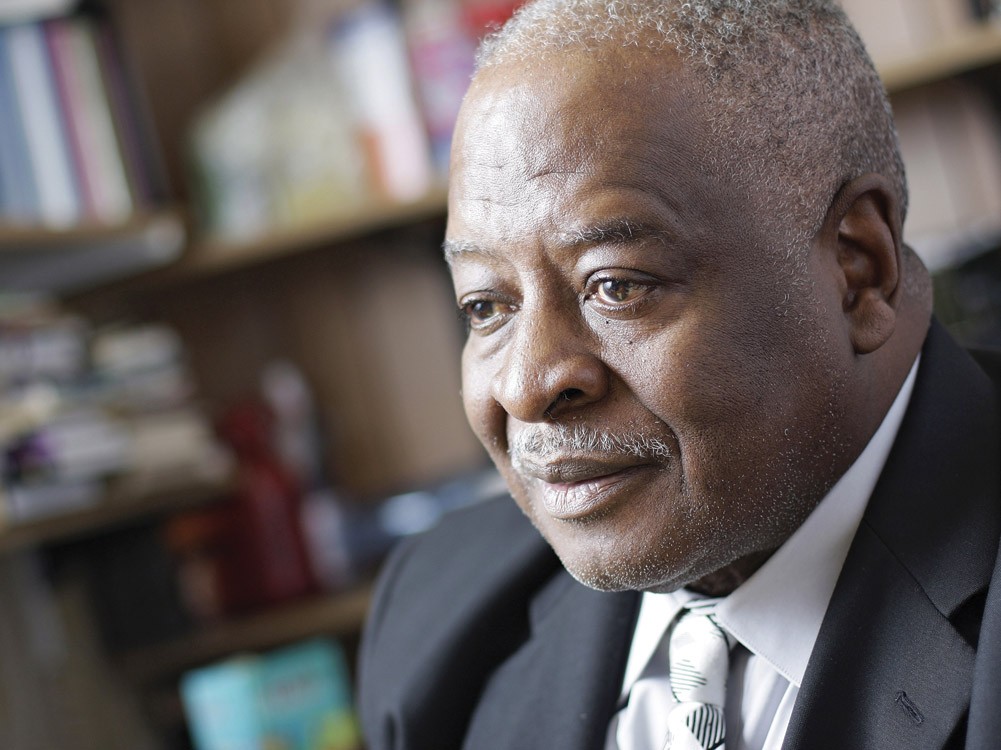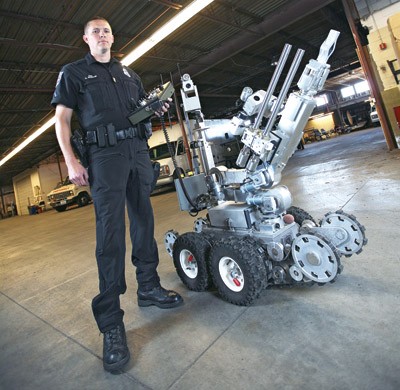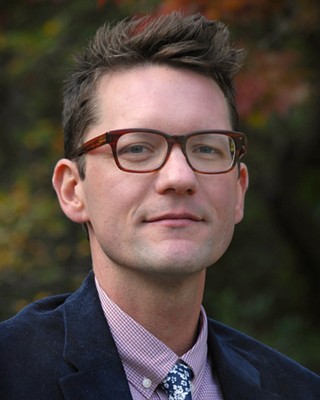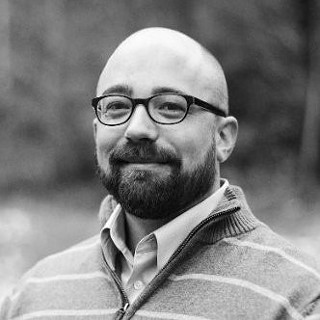Perspective: Temp worker who found the bomb
“It had some crap in it that looked fishy”
BRANDON KLAUS, 22, was one of three temporary workers who found the bomb before it could leave a crater in downtown Spokane, but he doesn’t think he did much.
“I was just doing my job. We found a backpack. It had some crap in it that looked fishy,” he says.
They called the cops, and then they waited.
Their first thought was that they might have found some stereo equipment, he says. Then, after seeing wires, antennas and something that looked like a light or maybe some sort of sensor, they called it in.
Then, it was Klaus who stood on the corner trying to keep parade-goers away from it, he says.
“Looking back now, I know I never should have been standing anywhere near it,” he says. “It seemed like that’s what you’re supposed to do.”
Klaus doesn’t watch the news. He doesn’t read newspapers, and he’s not really sure how the investigation into Kevin Harpham has gone. He’s got a girlfriend, two kids and a dog. He’s lived in Spokane his whole life. Today he works at Lowe’s and has a goal to make a stranger smile every day.
Between calls from the FBI and correspondence from lawyers, Klaus says he’s more annoyed with subpoenas and how long the legal process has taken than he is interested in seeing justice served. In fact, he says, he just wants the whole thing to go away.
“I wish I hadn’t been working that day,” he says.
And when he considers the attempted bombing in the wider context of the country — or the city where he grew up — Kraus comes to no deep, philosophical conclusions. He doesn’t think “homegrown terrorism” is a real thing. He doesn’t see any reason to be afraid.
“There are wackos everywhere. They’re not targeting us in Spokane. They weren’t targeting people in New York,” he says.
“People hate people. There are good people and twisted, messed-up people all over.” (Heidi Groover)
Perspective: Bomb Technician
“Somebody is going to have to go down there”
The sun rose to a cloudless day at 7:32 on Jan. 17, 2011. It was just above freezing, and 34-year-old SHAWN PEGRAM would be at work in a couple of hours.
Like on any other day, the nine-year veteran of the Spokane Police Department would get dressed in his uniform, readying for his shift patrolling the northeast side of town. He would work the swing shift, and go home to his wife and kids.
But this day was different. At 9:26 am, someone called 911.
“Hey, there’s a potential explosive call going on downtown,” a sergeant told Pegram, one of only 12 FBI-certified bomb technicians in the region. “They’re asking for you down there.”
Pegram jumped into the Explosives Disposal Unit truck. When he arrived on scene, the area surrounding the intersection of Main and Washington was already cordoned off about a block in each direction.
After getting a rundown from other cops on scene, Pegram and his team set up camp a block to the east, near the Spokane Public Schools building on Bernard. He crawled into the trailer behind the truck — the EDU’s command center for the day. As lead bomb tech, he’d be controlling the robot, which many in the department call “Elvis.” (Pegram insists the robot has no name.) Elvis looks like something NASA would send to Mars, with his one articulated arm and his many eyes, wheels and tank tracks.
Beside Pegram and Elvis were the team’s three other members: Sheriff’s Lt. Matt Lyons supervised; Sheriff’s Cpl. Mark Fox was the assistant tech, who would later don a 90-pound “Hurt Locker” suit; and Sheriff’s Deputy George Yingst stood by making sure no one took any undue risks.
With the wind gusting in a southwesterly direction, Pegram sent Elvis to the bench at Main and Washington where the suspicious backpack had been found. Then they took their time.
“Once we have an area clear and there’s no people in harm’s way, there’s really no rush,” Pegram says. “We can slow down. And be more methodical about it.”
Within the first hour, says Pegram, they knew that what they were dealing with was not normal. “[The bomb] was more complex than average. Someone put some effort into it.”
Inside the backpack was a wooden box. Inside the box, a 6-inch-long, 3-inch-wide pipe was welded to a steel plate. Two insulated wires connected to a model rocket igniter went into a hole near the base of the pipe. Inside the pipe was a plastic bag containing 100 grams of black powder and 128 lead fishing weights coated in brodifacoum, an anticoagulant found in rat poison.
Pegram and Elvis worked to defuse the bomb. And worked. And worked. Citing safety concerns, Pegram wouldn’t say what diagnostic or defusing tools his unit uses. Regardless, eight hours passed, with Pegram staring at the one computer monitor in the trailer and Elvis working with his one arm. It got cooler, and the sun went down at 4:28 pm.
Finally, Pegram told everyone the bomb was “rendered safe.”
“The mantra in the bomb squad world is ‘Start remote, stay remote,’” says Pegram. “Which means, use of a robot or however we can approach the situation without having to put somebody over the top of a thing. … But at some point somebody — some body — is going to have to go down there and approach the thing.”
Fox, the assistant tech, put on the hot, heavy, green bomb suit. He was in it for 20 minutes. The bomb was dead, and evidence collection began. “Every pebble” was searched. Still, Pegram says, it was just another day.
“At the time, it felt like another call and we handled like we do every other call,” Pegram says. “In hindsight, it obviously wasn’t just another call. … It would have been a tragic situation. It would have been devastating for Spokane.” (Nicholas Deshais)
Perspective: Director of Hate Studies
“Hate can exist anywhere, everywhere and nowhere”
JOHN SHUFORD had been on the job just two months when it happened. The new director of Gonzaga’s Institute of Hate Studies was busy planning and preparing to host a conference that would bring people from a dozen different academic disciplines — and as many countries — to Spokane to address the reasons and motivations we have for hating each other so deeply.
On that day, he hadn’t gone into the office. He’d stayed unplugged. He didn’t hear until late in the day that someone had left a suspicious package on the route of the Martin Luther King Jr. Day parade, which is often clogged with families and children.
“As someone who is devoted to educating other people’s children,” he says, “I felt distressed and heavy-hearted.”
He wasn’t particularly surprised, though. Not because of the region’s history. Portland has more hate groups than we do, according to the Southern Poverty Law Center. Seattle metro does, too. There is no clear demographic of hate, Shuford says. It follows no borders. The digital age has made old impediments as porous as sieves. In the world we live in, “Hate can exist anywhere, everywhere and nowhere.
“Even those who act on their own and live in isolation learned to hate,” he says. “We are social creatures through and through.”
What has been fostered by people, then, can be undone by them, Shuford believes. An integral part of life is suffering. How we deal with it — as individuals and as communities — goes a long way to staunching that suffering, rather than perpetuating it.
“What it means to be a moral community is to respond to suffering in healthy ways,” he says.
The good news is that there are just as few boundaries to promoting health as there are to spreading hate. Shuford’s job at the institute is to get people talking and thinking about that societal health — about staunching the suffering that leads to hate. After Jan. 17, that job got more urgent.
The job now also has some added help. After the backpack, after Tucson, after Portland’s Pioneer Square, after Oslo, “people are paying real attention to what’s happened,” Shuford says.
“I hear and see a lot of people in this region focusing on what kind of community we want to be, how we treat and help each other, and how we address [our] problems.”
It takes communities to teach hate. It will take communities to destroy it. (Luke Baumgarten)
Perspective: Activist
“I am disappointed … with the FBI and law enforcement”
As word spread about the bomb in the backpack, RACHEL DOLEZAL started receiving texts messages from worried friends who speculated that she might have been the target.
“In the flurry of the moment, people had random ideas about it, saying, ‘Oh, if you would have been in the march, it would have been detonated,” recalls Dolezal, 33, an outspoken black activist and professor who used to work at the Human Rights Education Institute in Coeur d’Alene.
That might have sounded a bit crazy to Dolezal if she hadn’t been targeted before. In 2010, when she was living in Coeur d’Alene, a noose was hung from the rafters of her carport. That was after she woke to find a noose on her doorstep in north Spokane the year before. After someone wrote (and misspelled) the n-word on the sidewalk of a friend’s home where she was staying. After her neighborhood was blanketed with Aryan Nations fliers. After she was confronted by skinheads who came to the Human Rights Education Institute asking questions about her and her family. And after someone tried to lure her son into a car with candy.
No one has ever been arrested in connection with any of these crimes, she says.
“I am disappointed in a general sense with the FBI and law enforcement,” Dolezal says. “It baffles me, knowing the evidence, that nobody was apprehended. I kind of wonder: Was there really a big effort?”
So it is with mixed feelings that she looks upon Kevin Harpham’s plea deal. On the one hand, someone is being held to account for a racially motivated attack and, by his own word, he’s guilty. On the other, the proposed sentence of 27 to 32 years means he could get out and terrorize people again.
And without the glare of a public trial, an opportunity for a broader community discussion might be lost, she says.
“Hopefully people won’t stop talking about it … but unfortunately we need things like trials to keep us focused and inspired.” (Jacob H. Fries)
Perspective: Harpham’s hometown
“I do know people who know him, but I’m not going to say”
On Highway 395, about 60 miles north of Spokane, is ADDY, WASHINGTON, a small town of 300 tucked in forested foothills, a relatively rural place where someone can live and work practically unbothered and unnoticed.
So it’s hard to find people in this part of rural Stevens County who know Harpham. Following his arrest, basic details about his upbringing were soon reported: He attended school in Kettle Falls until his junior year, then graduated high school in Colville, the largest town in the area and the seat of Stevens County.
Only one person remains in the Kettle Falls School District who seems to have had Harpham as a student. Once a teacher, now the superintendent, Greg Goodnight confirmed that he had Harpham in class but couldn’t elaborate, saying it was over 20 years ago. Ask around at local bars and restaurants and a familiar pattern emerges: No one knows or can pinpoint anyone else who knows him — even people who went to school at the same time.
At the Addy Inn restaurant and lounge hangs a humorous bumper sticker near the bar, reading: “For a small town, this one sure has a lot of assholes.”
Linda Clark cooks, waits tables and answers phones at the inn. She and her husband, Doug, who died last year, began running the place 17 years ago. Clark was surprised to learn that a suspect in such a high-profile case was from the area where she’s lived and managed restaurants her entire life.
“Apparently he never came in. I usually know people pretty well. I’ll introduce myself,” she says, noting that, after the arrest, everyone who came in talked about the case, but no one admitted to knowing him directly.
But people do know and recognize him. A gas station attendant in the area who asked not to be identified knows Harpham as a regular customer, buying gas and food about once a week. The attendant said it is unfortunate that Harpham’s actions have brought this level of attention to the area and its residents, but was quick to add: “If it is true.”
Another convenience store clerk in the area was more cautious, saying, “I do know people who know him, but I’m not going to say. I can’t do that.”
At the Inn, Clark speculates that Harpham “must not have been an outgoing person, or something,” pausing to flip food on the grill. “He must have just stayed home.” (Scott A. Leadingham)
Perspective: Oklahoma City bombing survivor
“I take note of these far-right-wing actions”
The sky was clear that morning. At least that’s how DENNIS PURIFOY remembers it.
On that day (April 19, 1995), at that time (9:02 am), the 43-year-old Social Security Administration worker was frustrated, trying to retrieve workload reports with a new computer system and ...
In one second, a white flash knocked him off his chair in the Federal Building in Oklahoma City. In the next second came darkness — a 5-foot-wide ceiling tile crashed on his head. Dust clogged the pitch-black air. He didn’t know if he still had his eyesight.
“I started calling for help,” Purifoy says. “I was yelling ‘help’ over and over again.”
Someone grasped his hand and helped him to his feet. He’d soon learn that 16 of the co-workers in his office were killed. He’d go to funerals, he’d visit hospitals, he’d get depressed, he’d get angry, he’d seek counseling.
Purifoy became fascinated with the bomber himself, Timothy McVeigh, a right-wing, anti-government extremist who drove a rented truck underneath the Federal Building and detonated a massive homemade fertilizer bomb. The explosion, equivalent to 4,000 pounds of TNT, killed 167 people and injured nearly 700.
Purifoy sat in the gallery of McVeigh’s trial for a few hours, to see the man who killed his friends in person. “I thought he was extremely young,” Purifoy says. “He’s a guy you would be thinking would say, ‘Do you want fries with that?’”
He researched McVeigh’s life. He read a book McVeigh was arrested with, The Turner Diaries — an extremist future-fantasy of a bombing of the FBI headquarters sparking revolution. (Prosecutors revealed that Spokane bombmaker Kevin Harpham also owns a copy of the Turner Diaries.)
Purifoy isn’t an expert on the Harpham case, but as a survivor of another terrorist attack, he had several reactions. First: relief that the workers spotted the bomb and told someone.
“It’s real easy to say, ‘It’s not my job’” Purifoy says. “We all need to take responsibility.”
Second, though it’s not as bad as it once was, each time he hears about a new attack, he feels traumatized again. He says the September 11 attacks were especially hard on him. That’s part of the reason why victims of terrorist attacks connect with each other, searching for solace and support. Purifoy has visited Ground Zero. New York firefighters often visit Oklahoma City.
And third, he sees the Spokane and Oklahoma terrorists as connected by ideology. “There are still a lot of people out there who hold those same beliefs,” Purifoy says. “I take note of these far-right-wing actions. I take note of it more than most people do.”
Fear over Islamic extremists, he says, has overshadowed the homegrown fringe. But they’re still there. He saw it in the guy who flew into the IRS building in Austin, Texas, and he sees it in Harpham. He says he’s all for free speech but worries our words become twisted in the minds of extremists.
Too few people, Purifoy says, challenge extremists on their beliefs. They become deluded to believe there’s a large part of the population that secretly agrees with them.
“Most people, when they read their news, they say, ‘Oh, it’s terrible. It’s another nut doing something.’ To me, yeah, they’re nutty. They’re in this far-right-wing fringe. But they’re not isolated,” Purifoy says. “Anyone with the Internet can fill up on that stuff real fast.” (Daniel Walters)
Perspective: Local Pastor
“We’re going to be unmovable”
While many people in the region — the nation and world, too — followed the coverage of the attempted bombing on Jan. 17, REV. PERCY “HAPPY” WATKINS was largely unaware. He attended an early rally but left before the parade, having two other speaking commitments that day. When the New Hope Baptist Church pastor did find out what had happened, it was from a New York Times reporter calling to get his reaction. Watkins was in Lewiston, Idaho, by that time.
His first reaction: shock.
“I said, ‘Wow, it’s 2011 and we’ve been doing this march for over 20 years and never had a real incident of this magnitude.’”
That shock of an attempted act of terrorism and hate quickly led to introspection and asking the inevitable “What if?” question.
“I shudder to think what would have happened here,” he says. “That’s when it started to hit me. Even if it didn’t go off, but what if it did go off? Oh, my gosh.”
October will mark Watkins’ 50th year in Spokane. He came here by way of the Air Force. He stayed, got married, raised four boys who still live in the area, and became a local fixture in the civil rights and black community. He’s known regionally for re-enactments — with no script — of Martin Luther King Jr.’s iconic “I Have a Dream” speech.
Since that day in January, through the police investigation and eventual arrest of Kevin Harpham, Watkins has remained optimistic. He says the community’s response has been positive, and, as many eye-opening situations do, it has made the community stronger.
“We have encouraged each other to not let anything turn us back,” he says. “That we’re going to be unmovable. As we plan for the next MLK celebration, it’s going to be bigger, it’s going to be better.”
Watkins says that as he’s traveled around the area, he’s been aware and on guard, given the region’s history with white supremacists, but he still always felt safe. He can’t recall encountering any specific racially focused hostility over the years.
When news came that Harpham had been arrested, Watkins says he was relieved. He followed much of the post-arrest coverage and is satisfied that federal and local authorities have done a good job. He believes the case against Harpham is a solid one.
“Knowing the high profile of the FBI and this agency, they took all the steps,” Watkins says.
What he is worried about, however, is people missing what he calls “the cry of the black community” following this incident. That cry, he says, is a need for more jobs and more visibility for minorities in the region.
“There’s still profiling going on. There’s still, I feel, a lack of respect for the black community.
“I don’t believe our voice is being heard.” (Scott A. Leadingham)


























